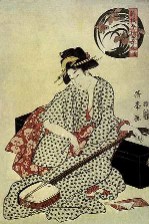Fascinating Facts about the Japanese Geisha
Fun Trivia, History Trivia The world of the Japanese Geisha is mysterious as it is glamorous. Recent books like Arthur Golden’s Memoirs of a Geisha are returning this pleasure girl to a popularity she has not enjoyed since World War II. The following article chronicles the history of this illustrious group of women.
The world of the Japanese Geisha is mysterious as it is glamorous. Recent books like Arthur Golden’s Memoirs of a Geisha are returning this pleasure girl to a popularity she has not enjoyed since World War II. The following article chronicles the history of this illustrious group of women.
Some have likened them to European courtesans, but the Japanese Geisha was something quite unique unto herself despite some of the obvious similarities. To call them prostitutes would be insulting-to the Japanese, they were artists skilled at conversation, singing, dancing, music, and, of course, love-making. Secrecy surrounded the Geisha’s talents. Many might have supposed that her sexual skills made her so needed by her clientele, but it is now thought that her ability to converse and sooth the ego of her lover was what set her apart from other women.
The arts practiced by the Geisha were expensive and only the upper class Japanese man could afford her. Geisha girls went through years of training and endured daily elaborate preparations to become the playthings of the wealthy. But thousands of years before the Geisha entertained men from their pleasure quarters, Kyoto was the center of a culture that equated love with art and beauty.
The Japanese Heian period lasted from 794 to 1195 and Kyoto was its capital. It is looked back on as a leisurely period in Japanese history – a period of love and poetry. Women were kept secreted away from men, but Heian noblewomen were highly educated. In fact, the world’s first novel, The Tale of Genji, was written by one such noblewoman named Murasaki Shikibu.
It is this period, that the Geisha sought to emulate with their own traditions during seventeenth century and beyond. Before they were known as Geisha, women had been living in the Japanese “pleasure quarters” to fulfill an acknowledged need in society. Since marriage was an essentially political arrangement, love must be gotten somewhere. Men were not supposed to receive sexual gratification from their wives who were simply supposed to deliver heirs.
Consequently, the pleasure quarters drew men from all walks of life. Kyoto became a center for prostitution and fallen women could be seen walking the streets. One in particular, around 1603, set up a stage on which she danced for onlookers who became riveted to her movements. Historians believe that it is this prostitute the later Geishas modeled their behavior on.
Girls were sent to the pleasure quarters often about the age of six. Always from poor families, these girls were taught to put the needs of her family above her own. Families would sell their beautiful daughters to the brothels in order to support other children. From the time of their initial purchase, these young girls incurred great debt – every meal or bit of clothing from their childhood days was calculated into their debt not to mention their training. It was not until she became a geisha that a girl could begin to pay her debt with the brothel owner.
Young girls in the pleasure quarters began as maids who attended older courtesans who would instruct them in the tea ceremony and calligraphy. As time went on, they would learn music and the arts of love. Girls would be taught how to fake pleasure and so conserve themselves for the next customer. Geisha were supposed to “play at love” but never succumb to it.
At their height, geisha girls enjoyed the company of princes and noblemen throughout Japan. Their secrecy helped to keep their status as the highest and most sought-after courtesans. Lesser prostitutes were not skilled in the arts that geisha had trained their whole lives for. Also, meeting with a geisha did not automatically result in sex. A proprietor who owned a beautiful courtesan charged expensive rates for courtships and geisha could not give up their charms so readily before being adequately compensated.
While the geisha grew up within a world of women and was instructed by them, jealousy among them was a fact of life and competition for wealthy men was keen. In this way, Memoirs of a Geisha is not far off the mark from portraying the life of a young geisha. Of course, close bonds were formed as well between “older and younger sisters” who neither were actually in control of their lives or fate.
Generally, a girl became a geisha after her ritual mizuage, or deflowering which often took place at the age of thirteen. Deflowering a beautiful maiko, the stage before one became a geisha, could be as expensive as buying a house. Once she accomplished the fact of shedding her virginity, the geisha could begin to earn her keep.
The world of the geisha continued for centuries but really came to its traditional end by the end of WWII when the society collapsed under their defeat. Today’s geisha have adapted, but there are laws governing their sale into brothels and young girls may no longer undergo the mizuage under law. Nevertheless, the geisha are highly revered in history and will continue to be remain popular as icons of sex and art.

Thank you! Another fascinating blog! I love this site. You make my morning.